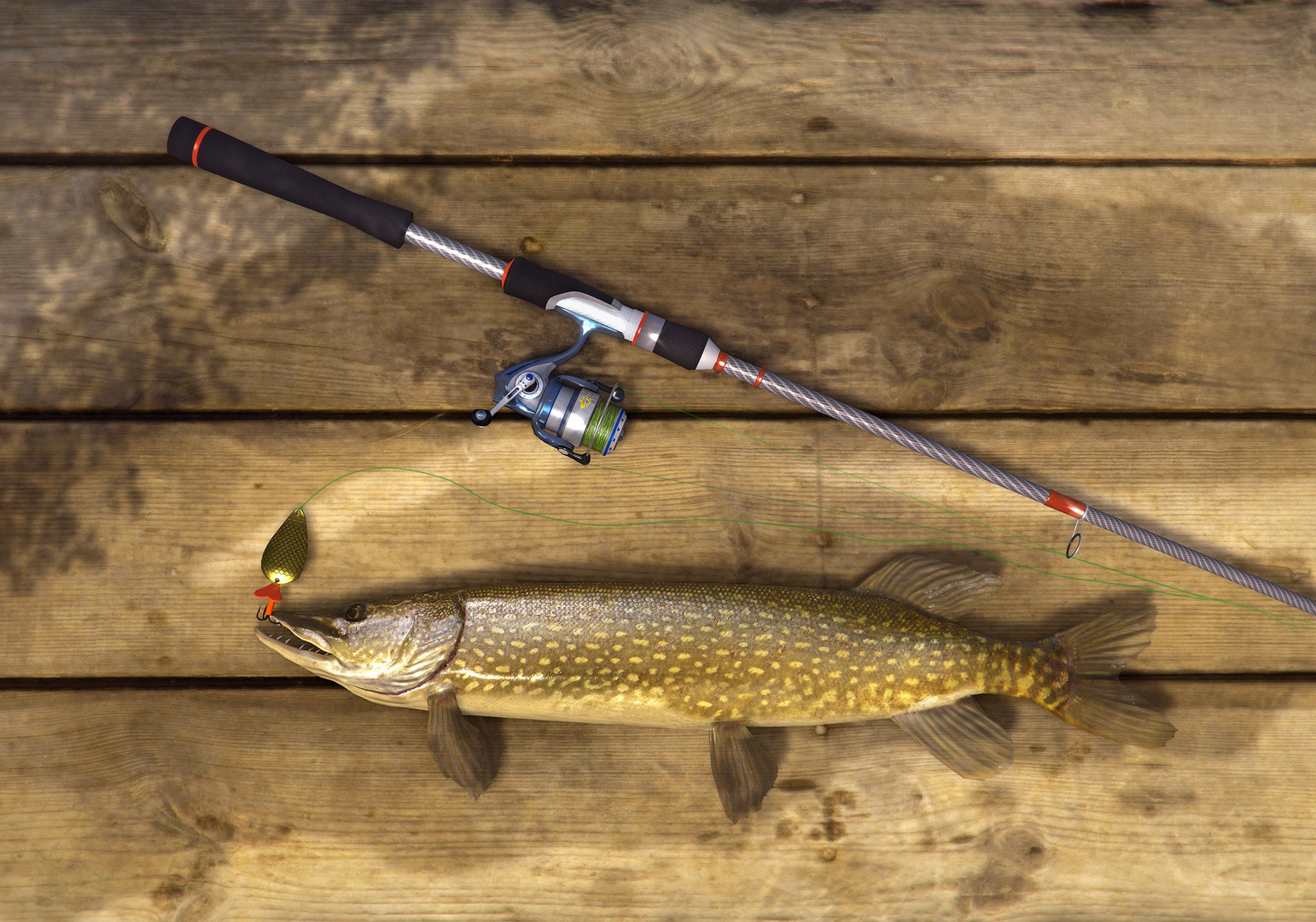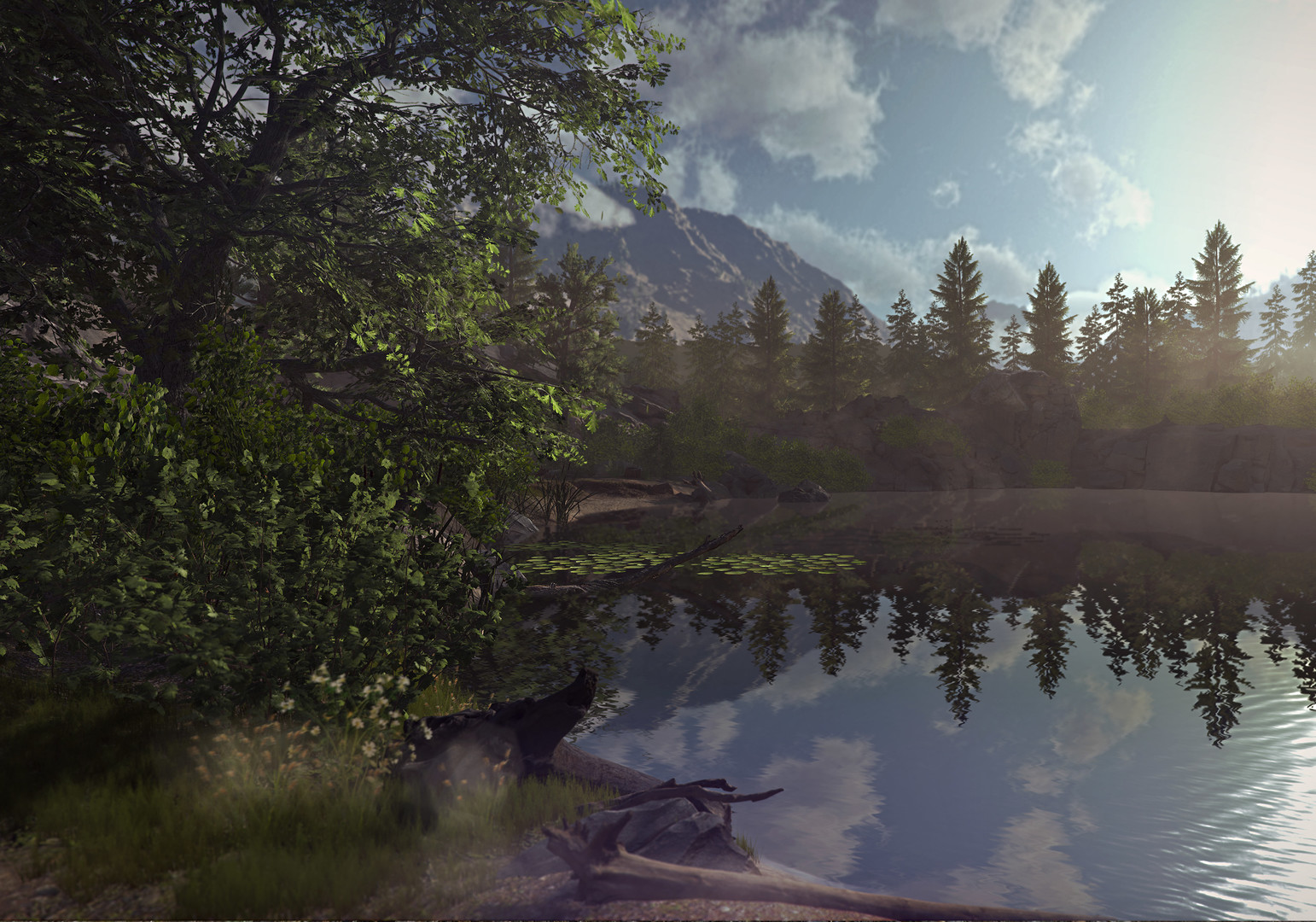The game is FREE to play and just a download away!
Aside from a rare few, there were no decent fishing games created over the whole 30-year history of game development. And not a single one in recent years! Don’t we anglers deserve better than that?
Fishing Planet decided to set this historic injustice right and finally make a game that fishing enthusiasts were waiting for all these years! And according to our Beta Testers, we hit the mark!
Fishing Planet isn’t just another game about fishing. Stunning eye-candy graphics, superb hydro and aerodynamics, realistic tackle behavior and damage based on actual simulation physics and, most importantly, fish with artificial intelligence for completely lifelike behavior make this a true-to-life fishing simulator that can help you improve your actual angling skills!
The combination of unique graphics, realistic game physics and sophisticated AI will bring the realistic world of fishing directly to your computer screen!
Key features:
- 32+ species of fish, each with its unique behavior and AI.
- 7 scenic waterways with multiple locations, various climatic conditions, bottom terrains and vegetation.
- Thousands of tackle combinations with unique physical and hydrodynamic properties.
- Superb dynamic water graphics with ripples and surface that changes depending on wind, current and depth.
- Weather – day/night alternation, change of seasons, different weather conditions (rain, fog, bright sunshine)
- Multiplayer capacity – online tournaments with personal and team scores, system of achievements, leader boards and top-player lists.
What makes us different:
- Complex AI system for fish behavior that correlates with seasonal and climatic change, time of day, speed of water current, bottom contour and type (color and structure), water and air temperature, wind, etc. Biting/striking reactions for each fish species are completely realistic and natural as well as specifics of lure attacks.
- Photorealistic graphics – using latest high-end tools for ultimate photo-realism: photogrammetry, all waterways are based on real location.
- Unique system of game physics and realistic tackle damage – rods, lines and reels break according to their actual individual characteristics. Realistic aero and hydrodynamic environment for lures and retrieves.
- Dynamic water graphics – splashes, waves and ripples on the water create a fully realistic fishing atmosphere.
- Weather – change of conditions depending on location, season and time of day. Possibility of sudden rain or sunshine breaking through the clouds.
- Tournaments and fishing duels – created based on world’s most popular fishing competitions.

Hey Anglers,
Welcome to the next stop in our journey the Maldives, a true gem of the Indian Ocean and a paradise for sportfishing enthusiasts. We've already introduced this breathtaking location in our previous DevDiary now it's time to dive deeper and explore the incredible fish species that call these waters home.
Swaying palms under a blazing sun, crystal-clear waters brimming with life, shimmering fish darting just beneath the surface we are creating the Maldives at their finest. The dry season has settled in, bringing perfect conditions for ocean fishing. A tropical paradise where Yellowfin Tuna, Wahoo, Mahi-Mahi, Sailfish, and Marlin are entering their peak feeding frenzy.
The geography of the Maldives plays a key role in shaping the habitats where different fish species thrive. Spanning the Indian Ocean, the islands are arranged in two parallel chains of atolls that rise from a deep oceanic plateau. Between them lies the Inner Sea a calmer, more sheltered area rich with diverse fishing grounds. Venture west, however, and youll encounter the true open ocean: expansive, untamed, and brimming with big-game potential.
This location will feature 28 fish species, including 14 completely new additions to the game. We will cover the new arrivals in this DevDiary, but youll also recognize some familiar faces from other regions. Species like Yellowfin Tuna, Bigeye Tuna, Albacore, Skipjack Tuna, and Dogtooth Tuna will feel right at home in these tropical waters.
Other well-known species such as Greater Amberjack, Giant Trevally, Narrow-Barred Mackerel, and Striped Marlin will also make an appearance here, taking advantage of the deep reefs and fast-moving currents. Even reef dwellers like Giant Grouper, Ruby Snapper, Mahi-Mahi, Striped Bonito, and Green Jobfish will continue their usual routines, now within the vibrant underwater landscape of Noomaa Kuda Atholhu. All of these species are already familiar to anglers from Kaiji No Ri but here, in the Indian Ocean, the warmer waters and open space allow some of them to grow even larger here, offering the thrilling opportunity to encounter their powerful Unique forms.
And of course, we cant leave out the Fish Monsters. Youll have to defeat two new monster fish: The Night Windrazor and The Hordecuda. You might be able to guess the real-life inspiration behind the first one and maybe even take a shot at what the second could be but were confident the Hordecuda will surprise you. As the Brave Angler, youll need to save the world first to uncover what these terrifying creatures truly look like, and we cant wait for you to discover it.
Lets start with the oceans most legendary hunters the Billfish.
Swordfish

The Swordfish (Xiphias gladius) is a powerful pelagic predator that can reach up to 1322 lb (600 kg). Found in tropical and temperate waters worldwide, though it may also roam into colder regions. It rarely approaches the shore, preferring the open ocean, where it moves between surface layers at night and depths of up to 1804 ft (550 m) during the day. A solitary hunter, the Swordfish feeds on squid, pelagic fish like mackerel and herring, and sometimes even tuna or small sharks. While most active at night, it also feeds in daylight.

Sailfish

The Sailfish (Istiophorus) is known as the fastest fish in the ocean. It lives in warm waters around the world and usually hunts near the surface, though it can dive as deep as 1968 ft (600 m) when needed. While Sailfish prefer the open sea, they often roam closer to shorelines, reefs, and islands, especially where the water stays deep and clear.
Active both during the day and at night, they usually hunt in groups, feeding on sardines, anchovies, mackerel, squid, and sometimes even crustaceans. Sailfish are also known to travel alongside tuna, which makes them a familiar catch in tuna fishing grounds.

Black Marlin

The Black Marlin (Istiompax indica) is a massive pelagic predator, found throughout the Indian and Pacific Oceans. Weighing up to 1653 lb (750 kg), its one of the most sought-after catches in both commercial and sport fishing. These fish prefer surface waters near coasts, islands, and coral reefs. While usually solitary, Black Marlins may appear in numbers when baitfish gather near the surface. Their diet includes small tuna, anchovies, mackerel, flying fish, squid, and crustaceans like shrimp and crabs.

As you can see, some of the Billfish you'll encounter are absolute giants, with weights reaching up to 1650 lb (750 kg). But dont worry youll have a chance to get fully equipped to take them on, with powerful gear and plenty of storage space aboard the new Chamaeleon catamaran.
Discover the Exotic Reef Species of Noomaa Kuda
Alongside the formidable Billfish, a wide variety of other species contribute to the vibrant underwater life of Noomaa Kuda Atholhu. While many of them arent giants, their coral reef habitats make them beautiful and exotic a true delight for anglers seeking something unique.
Great Barracuda

When something flashes past like a silver bolt and vanishes just as fast chances are, its a barracuda. The Great Barracuda (Sphyraena barracuda) is a medium-sized but formidable predator, found in warm waters across the globe. Weighing up to 110 lb (50 kg), it hunts in a wide range of habitats, from mangroves to outer reefs, always alert and ready to strike. This aggressive species bites in any weather, day or night. Young barracudas often move in groups, while adults prefer to go solo. Their main targets are small fish, with the occasional squid and shrimp only when theyre feeling generous.

Wahoo

Wahoo (Acanthocybium solandri) is a large predatory fish from the mackerel family, reaching up to 176 lb (80 kg). They live in open ocean waters but often stay close to coasts, reefs, and continental shelves. They hunt fish and squid, either alone or in small groups, and are known for striking from below with sudden bursts of speed about 50 mph (80 km/h). They're often spotted near tuna schools and are most active around sunrise and sunset, though theyll still bite at night just a little more slowly.

Indo-Pacific King Mackerel

The Indo-Pacific King Mackerel (Scomberomorus guttatus) is a medium-sized fish from the mackerel family, found in the warm waters of the Indian and western Pacific Oceans. Reaching up to 11 lb (5 kg) and beyond, this pelagic fish prefers coastal waters at depths of 49 to 262 ft (15 to 80 m). Its a prized catch for commercial fishers and a worthy challenge for anglers. King Mackerel travels in small schools , dining on sardines, anchovies, squid, and the occasional crustacean. They are active both day and night, so theres no bad time to go fishing for them. But beware - once hooked, these fish love to leap and thrash.

Two-Spot Red Snapper

The Two-Spot Red Snapper (Lutjanus bohar) is a long-lived Indo-Pacific species that can reach up to 33 lb (15 kg) and live over five decades. Found near reef slopes and sandy seabeds, it prefers oceanic islands to continental shores. Usually solitary, but it forms schools during spawning season. It feeds on fish, shrimp, crabs, snails, and mollusks and tends to bite best at dawn, dusk, or under a full moon.

Yellowstripe Scad

The Yellowstripe Scad (Selaroides leptolepis) is a small schooling fish found in the warm, coastal waters of the Indo-West Pacific. These agile swimmers thrive at depths of up to 229 ft (70 m), often gathering in large groups near the seabed over soft, sandy bottoms. Despite their size, Yellowstripe Scad are efficient predators with surprisingly large mouths. Their diet ranges from tiny zooplankton and invertebrates, like crustaceans and mollusks, to fish larvae and even smaller scad. While theyre mostly active during the day, theyve been known to feed at night too.

Gorgeous Swallowtail

The Gorgeous Swallowtail (Meganthias natalensis) is a jewel of the deep. Reaching up to 4 lb (2 kg), it prefers rocky slopes and deep reefs between 262 and 721 ft (80 and 220 m). These vivid reef-dwellers feed on small fish, mollusks, and crustaceans. They often share habitats with Ruby Snappers and Groupers, and remain active around the clock.

Sleek Unicornfish

The Sleek Unicornfish (Naso hexacanthus) is a graceful reef dweller, found from 39 to 114 ft (12 to 35 m) deep in lagoons and along coral slopes. This species tends to stay in large schools, making it a striking sight in its natural habitat. Omnivorous by nature, they feed on various zooplankton and algae. Its active in all weather conditions, both day and night, though it often ventures closer to shore after sunset.

Giant Sweetlips

The Giant Sweetlips (Plectorhinchus albovittatus) is a nocturnal bottom-feeder that prefers living alone near lagoons and barrier reefs. Found at depths up to 164 ft (50 m), it snacks on crustaceans, mollusks, and small fish. During the day, it retreats into deeper reef zones, emerging at night to feed.

Spotfin Flyingfish

The Spotfin Flyingfish (Cheilopogon furcatus) is one of the larger flying fish species, growing up to 13,8 in (35 cm) and weighing around 1lb (0.5 kg). Found in warm waters worldwide, it lives near the surface, whether in coastal areas or the open ocean. These fish stick together in small schools and follow currents that bring zooplankton to the surface. Their diet includes tiny crustaceans, mollusk larvae, fish eggs, and small fish. Active both day and night but especially drawn to light after sunset.

Sickle Pomfret

The Sickle Pomfret (Taractichthys steindachneri) is a medium-sized fish that lives in deep waters, usually between 164 and 2296 ft (50 and 700 m), often near underwater mountains or along continental shelf slopes. This fish is a group-hunting omnivore, feeding on small fish, squid, crustaceans, and tunicates. Its also a favorite meal for Bigeye Tuna, Swordfish, and Sharks. Since it lives in dark, deep waters, the Sickle Pomfret isnt tied to specific feeding times and bites both day and night.

Blacktip Reef Shark

The Blacktip Reef Shark (Carcharhinus melanopterus) is a sleek coastal predator that prowls warm Indo-Pacific waters. Weighing up to 44 lb (20 kg), it glides effortlessly across coral shallows and sandy flats. Adults stick to reef slopes and platforms, while younger sharks prefer calmer lagoons. Often seen in small schools, theyre quick, alert, and always on the hunt for reef fish, squid, crabs and occasionally even small rays or sea snakes.

We saved the Blacktip Reef Shark for dessert and for good reason. We know many players have been looking forward to more sharks in the game, and this one is a standout addition. While not the largest predator, the Blacktip is one of the most common and iconic sharks in the Maldives, making it a must-have for this location.
Theres also a special surprise waiting for those who take on the catamaran color customization missions. We wont spoil it for you, but lets just say if youre a fan of really big sharks, youre going to love what weve prepared for you.
We know many of our players are hungry for bigger sharks, and theyre definitely on the horizon. This is just the beginning of an epic shark chapter in the game.
To top it off, were also preparing another DevDiary that will dive into the gear, lures, and baits specially crafted for Noomaa Kuda Atholhu. Well also introduce a new retrieval technique and showcase the unique features of the Chamaeleon catamaran. From new setups to tropical tactics, theres plenty more coming to get your hands on. Stay tuned your next fishing adventure is about to get even better.
Until then tight lines and see you on the water!

_______________________________________________________________
Follow us on social media weve got some exciting giveaways coming this weekend to celebrate the upcoming release of the new location:
Discord Facebook Group
You are always welcome to ask for help in our support: support@fishingplanet.com
*All visual content in this DevDiary is crafted to showcase the upcoming features; however, there may be slight differences upon the actual release of the update
Minimum Setup
- OS: Ubuntu 12.04
- Processor: Dual core from Intel or AMD at 2.8 GHzMemory: 4 GB RAM
- Memory: 4 GB RAM
- Graphics: nVidia Geforce 8600/9600GT (Driver v331). AMD HD 2xxx-4xxx (Driver mesa 10.5.9). AMD HD 5xxx+ (Driver mesa 10.5.9 or Catalyst 15.7). Intel HD 3000 (Driver mesa 10.6)Network: Broadband Internet connection
- Storage: 12 GB available spaceAdditional Notes: External mouse or compatible Xbox controller required
Recommended Setup
- OS: Ubuntu 12.04
- Processor: Dual core from Intel or AMD at 2.8 GHzMemory: 8 GB RAM
- Graphics: Graphics Card with 2 GB Video RAM: Nvidia Geforce GTX 660 or equivalentNetwork: Broadband Internet connection
- Storage: 12 GB available spaceAdditional Notes: External mouse or compatible Xbox controller required
[ 6492 ]
[ 2513 ]
[ 1962 ]

